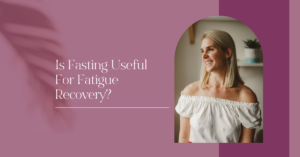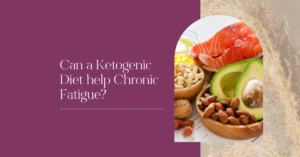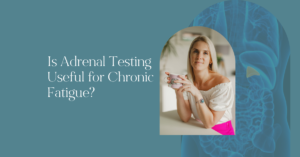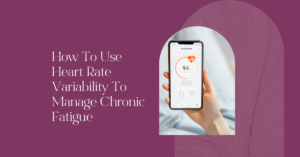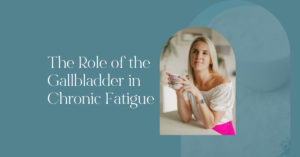Fatigue recovery starts with building stability in the body. We want to reduce the sense of threat where possible and promote a greater sense of safety and, in doing so, cultivate more of a parasympathetic state which supports rest, recovery and repair. One of the ways we do this, is with Circadian Rhythms!
Good sleep is the ultimate state of rest and unless you have been living under a rock, you probably already know that good sleep is going to be important for your health and energy.
I’ve written more extensively about sleep in previous posts and discussed it in episode 14 of the Chronic Fatigue and Burnout Recovery Podcast. Part of sleeping well is having a biorhythm which not only informs the most restorative sleep quality, but supports all the different systems of the body to function at their best.
A healthy biorhythm requires supportive circadian rhythms and both are an important part of regulating human physiology. We can harness the power of circadian rhythms to offer more stability in fatigue recovery.
What is a Circadian Rhythm?
A circadian rhythm is a natural, internal process that regulates the sleep-wake cycle and other physiological processes in living organisms, including humans. It is often referred to as the “body clock.”
These rhythms are influenced by external cues, such as light and temperature and they follow an approximately 24-hour cycle. They play a crucial role in various biological functions, including:
Sleep-Wake Cycle
The circadian rhythm is responsible for regulating when we feel alert and awake and when we feel sleepy or fatigued. It helps coordinate our body’s readiness for rest and activity.
Hormone Production
It influences the release of hormones like cortisol, which helps regulate metabolism and manage stress, and melatonin, which plays a key role in sleep.
Body Temperature
Circadian rhythms affect body temperature, which tends to be higher during periods of wakefulness and lower during periods of sleep.
Digestive Processes
The timing of meals and digestion is influenced by the circadian rhythm. For example, some digestive enzymes are more active during the day.
Cognitive Function
Cognitive performance, memory, and concentration levels can vary throughout the day in accordance with circadian rhythms.
Mood and Emotions
Circadian rhythms can influence mood and emotions. Disruptions to these rhythms are associated with mood disorders like depression and bipolar disorder.
Immune Function
Some aspects of the immune system are influenced by circadian rhythms. For instance, the body may be more susceptible to infections at certain times of day.
Cardiovascular Function
Blood pressure and heart rate can follow a circadian pattern, with variations over the course of a day.
How Are Circadian Rhythms Regulated?
The primary regulator of circadian rhythms in humans is the suprachiasmatic nucleus (SCN), a small region in the hypothalamus of the brain. It receives input from specialised cells in the retina of the eyes that detect light and uses this information to synchronise the body’s internal clock with the external environment.
Therefore, appropriately timed light exposure on the eyes is an important part of creating and maintaining healthy circadian rhythms and the biological functions listed above.
Disruptions to circadian rhythms, such as those caused by poor routine, shift work, jet lag, or certain medical conditions, can have significant impacts on health and well-being. Therefore, maintaining a regular sleep schedule and being exposed to natural light during the day are important for supporting a healthy circadian rhythm.
Circadian Rhythms and Energy
Fatigue is the end result of a body that cannot make enough ATP, through whatever mechanism – there are many.
For your cells to function properly they need the right materials in the right place at the right time. Thousands of genes have to be switched on and off in a specific order. Proteins, enzymes, fats, carbohydrates, hormones and other compounds have to be absorbed, broken down, metabolised and produced in a specific rhythm.
Energy has to be obtained, and then distributed appropriately to allow for growth, reproduction, metabolism, locomotion and cellular repair. When this network of systems works well, you can function optimally. When it is disrupted your biology becomes compromised and you feel it.
Disruption is created by the disruption of our circadian rhythms through light and dark exposure and our sleep and wake cycles.
This post will focus on the former, but worth mentioning is that as humans, we are often disconnected from the bigger cycles and rhythms within nature. For example, seasonal changes, temperature changes and changes in the moon cycles.
Disruption To Circadian Rhythms
It is disruption of our natural circadian rhythm that can impact sleep, blood sugar regulation, the immune system and therefore inflammatory responses, neurology and how fast we age.
A simple way to conceptualise this is by understanding the rhythm and interplay between cortisol and melatonin.
Cortisol
Cortisol is one of the body’s stress hormones and melatonin is the body’s sleep hormone.
A healthy individual will naturally experience a cortisol-awakening-response, also known as a CAR. This is an increase in the stress hormone cortisol which surges 30 minutes after waking.
Cortisol is an energy mobilising hormone. It can mobilise stored energy from the muscles and the liver to be used as fuel. It is your “get up and go” hormones which gets you going for the day. It should taper down as the day continues and it reaches its lowest point at around 2am. Good energy depends partly on a healthy cortisol rhythm and a factor in morning energy, is a healthy CAR.
Melatonin
Melatonin is the sleep hormone. Melatonin rises in response to the onset of darkness and adequate production supports good sleep. So here we can already see that good sleep requires healthy melatonin and healthy melatonin requires adequate exposure to dark and / or the absence of bright light on the suprachiasmatic nucleus.
Cortisol, Melatonin and the Immune System
It is noteworthy that there is a relationship between cortisol, melatonin and the immune system. Cortisol is anti-inflammatory and melatonin can be pro-inflammatory OR anti-inflammatory depending on the context.
At night time the immune system is more active. While the brain and metabolic system are resting, this is the perfect opportunity for the immune system to do “general housekeeping” – think of it like the cleaners in a big office building that come in and do their clean up at night-time when everyone has left work for the day to get their rest.
It wouldn’t make sense to clean the office in the day time with all the people around getting in the way and creating more mess. Just like it wouldn’t make sense for the immune system to come in during the daytime when the energy demands of the brain and metabolic system are high.
The surge in cortisol in the morning is an anti-inflammatory signal to the immune system that night time is over and it is time for the brain and the metabolic system to dominate again. This may sound familiar if you have ever had a cold or flu and felt worse in the early morning or early evening.
As a personal anecdote, sometimes when I was experiencing CFS symptoms I would wake in the night with muscle aches, a scratchy throat, convinced I am getting the flu. Once I wake in the morning and I get going for the day (and my cortisol response kicks in), I feel perfectly normal. This is an example of a more active immune system at night and of course, in my case, mine is a little more active than I would like at times.
So now you know that we have two hormones which are supporting your circadian rhythms. Melatonin, triggered by the onset of darkness and Cortisol, which is activated by light.
In modern day life there are many challenges that disrupt the cyclical release of cortisol and melatonin and this has potential consequences in inflammation, immune function sleep, ageing, blood sugar regulation and much more.
Examples of Circadian Disruption
Staying up late, artificial lighting or stress which also includes eating late or exercising late delays the melatonin curve. This is known as a delayed curve or delayed rhythm.
If the cortisol curve is triggered by light, this means that the two curves move closer together (see the diagram below). If the immune system is more active at night and the melatonin curve moves closer to the cortisol curve, we have immune suppression. Immune suppression can be associated with low grade inflammation, cardiovascular disease, depression and cancer.
The opposite is an advanced curve. This might be someone who is naturally a night owl, whose preference is to sleep at 3am or 4am but has to fit in with society and therefore goes to bed at 11am and wakes at 7am. This means exposure to darkness earlier than their natural rhythm would like.
Owls may have a less sensitive SCN when compared with morning larks. This means they need the sun to be higher in the sky before cortisol is stimulated and peaks. Therefore, by sleeping early, the melatonin and cortisol curves move away from each other and this creates a pro-inflammatory opportunity for the immune system. This may be associated with autoimmunity in someone who is genetically susceptible.
Does having a delayed curve mean you will get cancer? And does having an advanced curve mean you will get an autoimmune condition? No. It is a factor that can influence immune function and in the context of more energy, energy availability and optimal biochemistry.
Understanding Your Unique Chronobiology: Owls and Larks
Night Owls and Morning Larks are terms given to people whose natural biorhythms differ. You can take a quiz online to determine if you are an owl, lark or hummingbird (neutral), however, I find that most people already know.
A good question to ask yourself would be;
If you had no schedule or agenda, what time would you naturally want to go to bed in the evening?
If you had no alarm clock, what time would you naturally wake up?
Then, final question;
Does your life reflect your natural cycle?
In other words, compared to your ideal sleep schedule are you advanced or delayed? More simply put, do you go to sleep earlier than you would like or later than you would like?
It is normal at times for us to stay up late or need an early night. How are you doing day to day?
If you are aligned, then keep doing what you are doing. If you are not aligned, you have a few choices:
- You can adjust your routine to support your chronotype – this sometimes can involve the creation of healthy boundaries and communication with loved ones. It may take a little time, but definitely worth it.
- You can adjust light exposure to shift your biorhythm into better alignment with your needs.
Morning Light Exposure
Morning light is what sets up the cortisol awakening response (CAR) and therefore, everyone should be getting morning light exposure within 30 to 60 minutes of their ideal awakening time.
The ideal scenario is to wake up at the same time each day or at least within a 60 minute window. For example, as a super lark, sometimes I wake up naturally at 4:45am and sometimes as late as 5:45am. But sometimes also 5:15am and sometimes 5:30am. All of these are within the same 60 minute window and I normally do not use an alarm.
Within 30-60 minutes of waking get sunlight exposure on your eyes:
- 3 minutes on a sunny day
- 10 minutes on a partly cloudy day
- 20-30 minutes on a cloudy or rainy day
This should be without sunglasses and not through a window. In the colder months when days are shorter and the sun doesn’t come up for a few hours after waking, get as much bright artificial light exposure as possible and once the sun is up, get outside for some light exposure.
When I wake up at 5am in the winter and the sun doesn’t come up for 3 hours, I use a 10 000 LUX light box on waking and aim to get outside after the sun is up.
If you are able to combine your morning light exposure with exercise or movement, this can also help to stimulate the cortisol awakening response.
If for whatever reason light exposure in the morning isn’t possible, at the very least, aim to get outside at some point in the day without sunglasses.
Evening Light Exposure
In the evening, if you are able to get some light on your eyes before sunset this can also help to inform the biorhythm and generally speaking, the more time you can spend outside in the day, preferably in nature, the better.
As the sun goes down in the evening, you can use:
- Low level dim lighting in your home
- Candles
- Blue light blocking glasses, for example
- Filters on devices to adjust the light accordingly – examples: F.lux, Iris & Night Owl
You might also want to have appropriate black out blinds in your bedroom, I personally use this sleep mask which works better than any blackout curtains 🙂
Can You Change Your ChronoType?
Sometimes I have clients who would ideally be sleeping until 11am, but they have to get up for the school run or they would love to be in bed by 8pm but life just doesn’t work that way for reasons that feel too big to change right now.
What happens then?
The best thing we can do in these situations is create a routine that we are consistent with. If you would like to wake up earlier to take your kids to school, then you just have to make sure you train your body to get to bed earlier with a reasonable wind down routine and make sure that even on the weekends, you sleep and wake at the same time so that you train your body to accept an earlier rhythm as the norm.
Where the detrimental effects of rebelling against your chronobiology come in are likely to be when things are inconsistent. I.e. you don’t stick to the same or similar bed and wake times across the week.
Reflection Points
As you reflect on what you have learnt here and you work towards optimising your routines to stabilise your health, here are some things to reflect on.
- Do you have a consistent sleep and wake routine?
- Do you create space for morning light exposure in your morning routine?
- Do you spend some time outside each day?
- Are there any actions you can take to reduce evening light exposure or improve your wind down routine.



